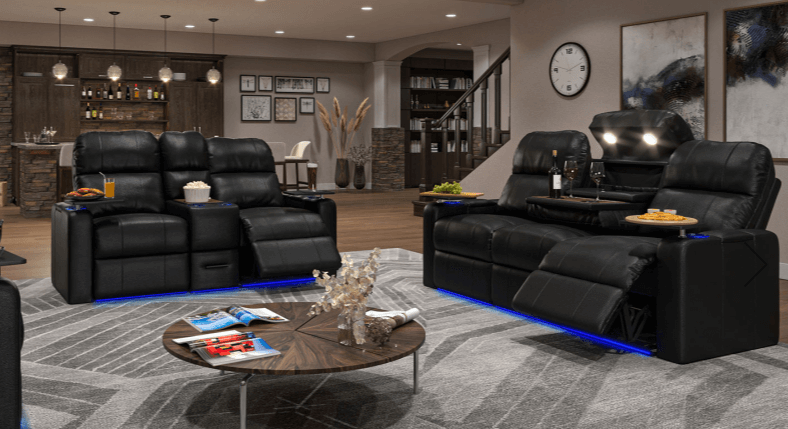The wiring of a home theater may seem like a very simple task, but it involves a lot of knowledge. Firstly, the wires should be selected correctly, and different styles of audio equipment require corresponding wires to match. Secondly, the wiring should be reasonable, with the line running straight and avoiding large bends as much as possible, as long surround lines can cause loss of audio signals and affect the sound quality of the speaker. Audio cable, video cable, and coaxial cable cannot be mixed. Their role is not just a green leaf, but it will take your entire audio system to a new level.

How To Wire Your Home Theater – Home Cinema Wiring Guide
1. Locate the speaker and then wire it
Before wiring, whether preparing to use embedded methods or laying exposed wires, the speaker should be determined before wiring. Because different models and styles of speakers have different requirements for the type, structure, and material of the wire. The progressiveness wiring is unreasonable and unscientific if the speaker model and placement position are not determined. Regarding the placement of speakers, the size of the room in the home theater should first meet the requirements of THX certification, and the length, width, and height should be proportional, such as l: 1.25:1.6 or l: 1.6:2.5. The placement of speakers generally adopts the “317 ratio method”. The “317 ratio method” refers to dividing the length of a room into three equal parts, placing speakers at one-third of the length, and the spacing between the two speakers is 0.7 times the length of two-thirds of the room.
2. Best time to cable your home cinema
Embedded wire
There are generally two situations with home cinema wiring: one is pre embedded, and the other is exposed wiring. Pre embedding usually involves considering the wiring carefully during the layout of a home theater or house decoration. Depending on the living room environment, it is expected that the installation of audio and video equipment will be completed in which locations. The placement of speakers will be designed, suitable wires will be selected, concealed power sockets will be hidden, installation holes will be pre installed, and so on. The wires will be buried during decoration. This makes the entire wiring very convenient and perfect, and the audio-visual space will not be affected by the variety of wires, which is the best method.
Open line
Not every family considers the layout of their home theater when they first renovate, or cannot determine what kind of speaker to choose for the home theater before the house renovation, but cannot renovate the house. Therefore, they cannot embed wires and can only use open wires. For many families, using clear wiring is a headache because they want to achieve both aesthetic and tidy appearance while meeting the requirements of cinema wiring. At present, there are two main ways to walk the open line. The first way is to walk the line against the wall, and it is best not to use horse riding nails. Another way is to install cable trays, which will be more aesthetically pleasing. But the speaker cable and video cable are generally very thick, and ordinary cable pressing slots cannot fit inside. Therefore, it is recommended to use stainless steel cable trays for exposed wiring. Currently, supermarkets and shopping malls use this type of cable tray, which can be adhered to the wall with glass glue, which is both beautiful and practical. If using an open line, it is best not to hang the surround speaker on a wall, use a bracket, and then cover the line with a carpet, which is more aesthetically pleasing.
3. Wiring construction
The wiring construction mainly includes the wiring of several types of wires, including speaker cables, audio cables, video cables, and power cables. For an ordinary 7.1 channel home theater, the specific wiring construction includes the following types of wires:
- 7 oxygen free high-purity copper speaker wires from amplifier to speaker;
- 1 digital high-definition video cable, HDMI or DVI, from the high-definition signal source output end to the projector;
- Analog video cable – component cable, s-terminal cable, composite video cable, 3 from signal source to projector;
- 1 digital audio cable, fiber optic or coaxial, from signal source to amplifier;
- 2 analog audio cables (signal source to amplifier) and 1 subwoofer cable (from amplifier to subwoofer);
- 1 power cord for projector and Projection screen.
Among several types of wires, the power cable is a key factor before wiring, while the speaker cable is the key point of wiring. The direction of the video cable depends on the installation method of the video equipment. And there is basically no need to consider audio cables when wiring, because the audio source equipment and amplifier are often placed together, and these cables are very short, which can be configured later.
4. Pay attention to power cables
In a generally good audio combination, the power cord of the audio system is separate from the body, and users can choose different grades of power cords according to their economic strength. Due to the fact that both projectors and televisions require 220V power supply, both weak and strong currents need to be arranged simultaneously during decoration, and the circuit must have a certain carrying capacity. Strong current generally refers to the power cord of the equipment, and home theater equipment has high requirements for power supply. It is best to directly pull a few wires separately from the incoming line. The wiring in the power box of the audiovisual room should be separated from the incoming and outgoing lines, and fixed in a rectangular shape according to the direction and current size, with wire cards used to secure them. And weak current mainly includes telephone cables, network cables, cable TV cables, audio cables, video cables, audio cables, and so on. The method of passing through pipes for weak electricity is almost the same as for strong electricity, which also requires PVC pipes. It is better to ensure that the cross-section of the line does not exceed 40% of the cross-section of the PVC pipe. Never wear too much, and strong and weak electricity must never be worn in the same pipe. In addition, the quality of various wires should strive to be excellent to meet the bottom line of 20 years of normal use.
5. The wiring of the speaker cable is the most critical
Connect one end of the speaker cable to the amplifier and the other end to the speaker. Due to the directionless nature of the bass, the subwoofer is usually placed next to the amplifier, and the subwoofer cables do not need to be wired. When wiring, the speaker cable should be as short as possible and the wire diameter should be as large as possible. However, if the power of the amplifier and speaker itself is not high, there is no need to use thick speaker cables. This not only wastes money, but also leads to poor sound, and in severe cases, it can also burn the speaker unit or damage the amplifier. During wiring construction, two single core speaker cables are often used to connect the speaker and amplifier on each side. Connecting both sides requires four single core speaker cables. This gameplay is called “single line splitting”, which is the most basic gameplay; If there are two independent “+” poles and two independent “~” poles on each side of the speaker and amplifier, then we should use four single core speaker wires on each side to connect the speaker and amplifier+.
If you want to order the best quality home theater recliners online, Linsen Seating is a reliable and professional home cinema seating manufacturer and supplier.

